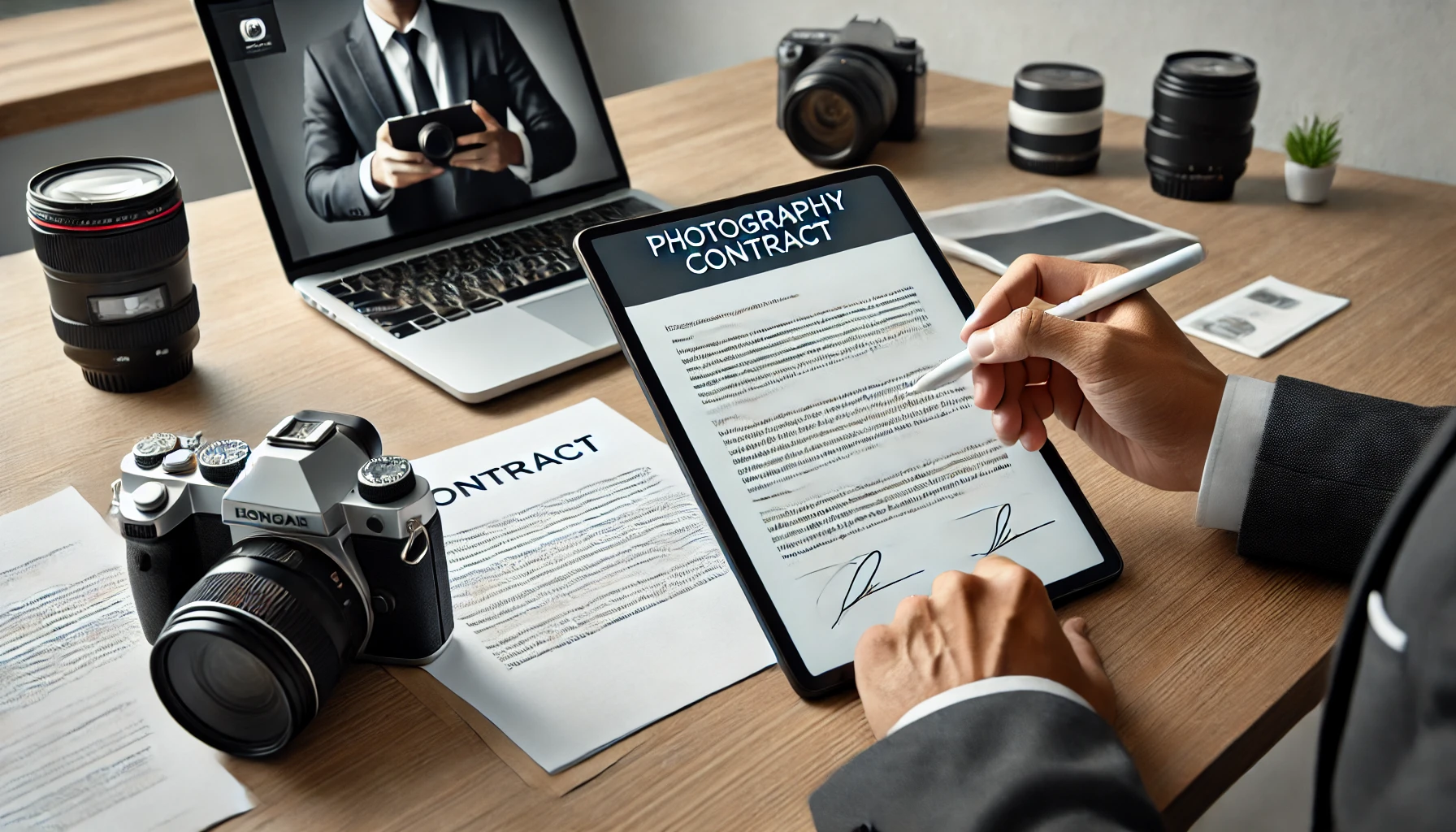As a photographer, whether you’re just starting out or running an established business, having a solid contract is essential to protect your interests and set clear expectations with your clients. A well-crafted photography contract not only shields you from potential legal issues but also ensures that both you and your clients are on the same page regarding the services provided, timelines, and payment terms.
By outlining every detail of your working relationship in writing, a contract helps prevent misunderstandings and protects your intellectual property, payment, and time. It also fosters trust, as clients know exactly what they are committing to, and you can confidently manage your business without worrying about potential disputes.
In this article, we’ll walk you through the key elements of a photography contract, explain how to create one that works for your business, and offer tips on how to customize it for different types of photography services. Whether you’re photographing weddings, portraits, or events, a clear and professional contract is your best tool for success.
Why You Need a Photography Contract
A photography contract is one of the most crucial tools for any professional photographer. While photography is a creative business, it also involves significant legal and financial responsibilities. Here’s why having a solid contract is essential for protecting both your business and your clients.
Importance of Legal Protection
A photography contract serves as a legal safeguard for both parties involved. It outlines the terms of the agreement and ensures that both you and your client are on the same page regarding expectations and responsibilities. In case of any disputes, a well-drafted contract can serve as a reference point, offering protection in a court of law. Without a formal agreement, you may find yourself vulnerable to misunderstandings, late payments, or even legal claims.
Establishing Expectations with Clients
Clear communication is key to building strong client relationships. A contract helps establish the specifics of what you’re offering, including the services you will provide, the dates of the photoshoot, and the deliverables. This eliminates the need for guesswork, allowing both you and your client to understand exactly what to expect from the collaboration. When expectations are set from the start, the likelihood of dissatisfaction or disputes down the line is greatly reduced.
Reducing the Likelihood of Misunderstandings or Disputes
Even the most professional photographer can face issues with clients—whether it’s about deliverables, timelines, or cancellations. A photography contract addresses these common areas of concern by laying out the terms in black and white. For example, you can clearly state how long the client has to request changes or edits to the images, what happens if the client cancels or reschedules, and how disputes will be handled. Having these terms upfront helps reduce the chances of conflict, offering both parties peace of mind throughout the process.
Protecting Intellectual Property and Ownership Rights
As a photographer, your images are your intellectual property. A contract should clarify who owns the rights to the photos after the shoot. This is particularly important if your clients intend to use your work for commercial purposes, such as advertising or marketing. By specifying the terms of image usage, you ensure that your work is protected and that you retain control over how it’s distributed or sold. Without these protections in place, you risk having your images used in ways that were never agreed upon, potentially leading to loss of revenue or unauthorized exploitation of your work.
In conclusion, having a photography contract is not just a formality—it’s an essential part of running a professional and protected business. It ensures that you and your clients are clear on what’s expected, reduces potential conflicts, and safeguards your creative work.

Key Elements of a Photography Contract
A photography contract is essential for clearly outlining the expectations and responsibilities of both you and your client. Below are the key elements that should be included in every photography contract to protect your business and ensure smooth collaboration with your clients:
Client and Photographer Information
The first section of your contract should clearly state the full names, business details, and contact information of both parties involved—the photographer and the client. This includes addresses, phone numbers, and email addresses, ensuring that both you and your client are easily reachable throughout the process.
Services Provided
In this section, provide a detailed description of the photography services you are offering. Be specific about the type of photography (e.g., wedding, portrait, event, commercial) and include crucial details such as the date(s) and location(s) of the shoot. Also, outline what the client will receive, whether it’s a set number of images, an album, or digital files, so there’s no confusion about what is included in the service.
Payment Terms
It’s important to outline the full cost of your services upfront. Include a breakdown of your pricing, payment schedules, and any deposit requirements. Be clear on the payment due dates (e.g., deposit at booking, final payment before the event, etc.). Additionally, clarify the method of payment (e.g., bank transfer, credit card, PayPal), and consider including late payment fees or penalties to encourage timely payments.
Cancellation Policy
Life happens, and clients may need to cancel or reschedule. Clearly outline the terms for cancellations, refunds, and rescheduling in this section. For example, you can specify that deposits are non-refundable but may be applied to a rescheduled date. Having a clear cancellation policy can protect you from losing income due to last-minute changes or cancellations.
Copyright and Image Usage
One of the most critical parts of your contract is defining who owns the photos and how they can be used. Clarify that, unless stated otherwise, you retain the copyright to the images you create. Additionally, specify how the client can use the photos—whether it’s for personal use only, online sharing, or commercial use. This section helps prevent misunderstandings regarding image rights and ensures that your work is protected.
Model Release
If your photography involves capturing the likeness of individuals (especially for promotional purposes), a model release is essential. This clause grants you permission to use the client’s images for marketing, portfolio display, social media, or other promotional activities. Be clear about the scope of the release, whether it’s exclusive to specific platforms or covers all uses of the images.
Delivery Timeline
Set clear expectations for when the client will receive their final images. Whether you deliver digital files via a download link, create a printed album, or offer both, specify the exact timeline for completion. A clear delivery timeline ensures that the client knows when to expect their photos and allows you to manage your workflow efficiently.
Limitation of Liability
This clause protects you in case of unforeseen events that might affect your ability to deliver services, such as equipment failure, illness, or natural disasters. Limiting your liability can prevent your business from bearing the full financial burden of such incidents. Consider specifying that you are not liable for any lost or damaged images beyond a certain point, like after the delivery of final products.
Dispute Resolution
In the unfortunate event that a conflict arises, it’s essential to include a method for resolving disputes. Whether you opt for mediation, arbitration, or another form of resolution, this section provides a clear process for resolving conflicts without going to court. Including dispute resolution methods can save you time and money if issues arise with your clients.
By including these key elements in your photography contract, you can protect both your business and your clients, ensuring a smooth and professional working relationship. Always tailor your contracts to your specific services and business needs to ensure they cover all potential scenarios.
Customizing Your Contract for Specific Services
When it comes to photography contracts, one size doesn’t fit all. Each type of photography service—whether it’s weddings, events, or portrait sessions—has unique requirements and considerations that need to be addressed. Customizing your contract for these specific services ensures clarity, protects both you and your clients, and reduces the risk of disputes. Here’s how you can tailor your photography contract for different types of shoots:
Wedding Photography
Wedding photography contracts require particular attention to detail due to the complexity and high stakes of the event. When drafting a wedding contract, make sure to include:
- Detailed Timeline: Weddings often have tight schedules, so it’s crucial to outline the start and end times, along with important moments like the ceremony, reception, and first dance.
- Second Shooter: If you plan to bring a second photographer or assistant, mention it clearly in the contract, along with their roles and any additional fees.
- Delivery Expectations: Be specific about how long it will take to deliver the edited images and any albums. Weddings can sometimes involve hundreds of photos, so setting expectations helps prevent dissatisfaction.
- Backup Plan: Weddings are a once-in-a-lifetime event, and you don’t want to leave clients in a bind if something goes wrong. Address your contingency plans for equipment failure, illness, or unforeseen events.
Event Photography
Event photography can vary widely, from corporate events to parties, and each has its own nuances. Here are a few custom clauses for event contracts:
- Event Duration and Overtime: Clearly state the hours you’re contracted for, and outline your overtime rates if the event runs longer than expected.
- Guest Interaction: Specify how much interaction you’ll have with guests and if you’ll be available for posed group shots, candid moments, or a mix of both.
- Venue Restrictions: Address any restrictions related to the venue, such as limited lighting, photography areas, or access to certain parts of the event.
- Cancellations and Postponements: Events are often subject to changes, so your contract should include terms for rescheduling or cancellations, including any deposits or fees that may be refundable or non-refundable.
Portrait Photography
Portrait sessions, whether family portraits, professional headshots, or personal branding, often require a more straightforward contract but still benefit from customization:
- Location and Number of Subjects: Specify the location of the shoot and the number of people involved, as pricing can vary depending on the session’s complexity.
- Wardrobe and Styling: If you offer styling or wardrobe suggestions, outline this in the contract, including any additional fees for hair and makeup services, if applicable.
- Image Usage Rights: Some portrait clients may want to use the photos for commercial purposes (such as advertising or social media). Be clear about image usage rights and fees if the photos will be used for commercial purposes.
- Retouching and Editing: Define the level of post-production editing included in the package. Some clients may expect heavy retouching, while others may want a more natural look. This helps prevent misunderstandings after the session.
Product Photography
For those specializing in product photography (e.g., for e-commerce or advertising), your contract should include:
- Number of Products: Clearly specify how many products you will be shooting and whether there are any additional costs for extra items or complex shots.
- Delivery Format and Resolution: Since many product photos are used online, make sure to discuss delivery format (e.g., JPEG, PNG) and resolution, especially if clients need high-quality images for print.
- Storage and Backup: Clients may request a backup of their images. Outline your policy for storing and providing backup files, as well as the duration for which you will keep the photos before deleting them.
Special Clauses for Specific Photography
For any type of photography, here are a few additional clauses you may want to consider:
- Travel and Accommodation: If you need to travel for a shoot, especially for destination weddings or events, make sure to include travel fees, accommodation details, and any other associated costs.
- Props and Equipment: If you’re using specialized props or equipment, such as backdrops, lighting, or a drone, mention any extra charges or logistical considerations for these items.
- Editing Preferences: Some clients may have specific requests for editing styles, color grading, or other post-processing work. If applicable, include these details in your contract to ensure you’re on the same page.
By customizing your photography contract to suit each type of service, you ensure that your clients know exactly what to expect, and you protect your business from potential legal issues. Tailoring your contract to your specific photography niche not only strengthens your professionalism but also builds trust with your clients, making your business more successful in the long run.

How to Make Your Contract Legally Binding
To ensure that your photography contract holds legal weight and protects both you and your client, it’s essential to understand the steps necessary to make it legally binding. Here are the key elements that can help you achieve this:
Importance of Signatures: Both Photographer and Client
A signature is one of the most important elements in a contract. It signifies that both parties have agreed to the terms and conditions outlined in the document. For a contract to be legally binding, it must be signed by both the photographer and the client. This shows mutual consent and acknowledgment of the obligations and rights specified in the agreement.
In the case of a dispute, the signed contract can serve as solid proof that both parties agreed to the terms. Therefore, it’s crucial that both parties take the time to read and understand the contract before signing. The signature indicates that both the photographer and the client are committed to fulfilling their respective duties under the contract.
Digital Contracts and E-Signatures
With the rise of digital tools, photographers and clients don’t always need to meet in person to finalize a contract. Digital contracts and e-signatures have become increasingly common and are generally considered just as valid as physical signatures in most legal jurisdictions.
There are several online platforms available that allow you to create, send, and sign contracts digitally. These tools provide security features such as encryption to protect the integrity of the contract and ensure that it hasn’t been tampered with. Platforms like DocuSign, Adobe Sign, or HelloSign offer legally recognized e-signature solutions, making it convenient for both you and your client to sign contracts from anywhere.
When using e-signatures, it’s important to make sure that both parties receive a copy of the signed contract for their records. This helps avoid future misunderstandings or disputes about what was agreed upon.
Consulting a Lawyer to Ensure Legal Validity (Optional but Recommended)
While you can create a photography contract on your own, consulting a lawyer is a great way to ensure that your contract is legally sound. Lawyers can help you identify any gaps, potential risks, or areas of ambiguity that could lead to issues down the line. They can also ensure that your contract complies with local laws, which may vary depending on your location and the type of photography services you offer.
A lawyer can also help tailor your contract to fit your specific needs, whether you are dealing with wedding photography, corporate events, or portrait sessions. While hiring a lawyer is optional, it’s highly recommended, especially if you are dealing with large-scale projects or clients who require more formal agreements.
By following these steps—getting signatures from both parties, using secure digital contracts and e-signatures, and considering legal advice—you can create a photography contract that is not only professional but also legally binding, ensuring the protection of your business and fostering a transparent relationship with your clients.
Best Practices for Using a Photography Contract
Once you have a solid photography contract in place, it’s important to follow best practices to ensure that both you and your clients are protected and clear on the terms of your agreement. Here are a few essential practices to follow when using a photography contract:
1. Reviewing the Contract with Clients Before Signing
Before the client signs your contract, take the time to thoroughly review it with them. This step ensures that both parties are on the same page and understand all terms and conditions. Walk your clients through the most important aspects, such as payment terms, delivery timelines, cancellation policies, and usage rights for images. By doing this, you reduce the chance of any misunderstandings or disputes down the road.
It’s also a good idea to encourage clients to ask questions if they’re unsure about any part of the contract. Clear communication during this step will foster trust and help avoid future conflicts.
2. Keeping a Copy of Signed Contracts for Your Records
Once the contract is signed, make sure to keep a copy for your records. Whether it’s a physical or digital copy, storing these signed agreements ensures that you have proof of the agreed-upon terms in case of any legal issues or disagreements. This documentation can be especially important if there’s a need to reference specific clauses regarding cancellations, payments, or deliverables.
For digital contracts, use a secure cloud storage system or a contract management tool to keep everything organized and easily accessible. It’s always better to be over-prepared and have these records readily available should you need them.
3. Updating the Contract Regularly to Reflect Any Changes in Your Business
Your photography business will evolve over time, and so should your contracts. As you add new services, update pricing, or change business policies, make sure to revise your contract to reflect these changes. Regularly updating your contract ensures that it remains accurate and relevant to the current state of your business.
Be sure to notify clients if there are any significant changes to your contract terms. This helps maintain transparency and keeps your clients informed about any new expectations. Regular contract updates will also protect your business from potential legal challenges that might arise from outdated terms.
By following these best practices, you can ensure that your photography contract serves as a clear, protective tool for both you and your clients, helping to avoid misunderstandings and protecting your business interests.

Tools and Resources for Creating a Photography Contract
Creating a solid photography contract is crucial for protecting your business, and thankfully, there are several tools and resources available to help you draft one that meets your needs. Whether you’re just starting out or looking to streamline your contract process, the following options will assist you in creating a professional and legally sound agreement.
Photography Contract Templates
One of the easiest ways to create a photography contract is by using pre-made templates. These templates can save you time and ensure that you’re including all the necessary clauses. Here are a few online tools and platforms that offer photography contract templates:
- HoneyBook: HoneyBook is a popular tool for photographers and other creatives that offers customizable contract templates. The platform provides a variety of templates for different types of photography services, such as weddings, portraits, and events. With HoneyBook, you can easily manage your contracts, payments, and client communication in one place.
- 17hats: 17hats is another great platform for photographers that includes contract templates specifically designed for photographers. It allows you to automate your workflows, including sending contracts for e-signature, invoices, and project management.
- Dubsado: Dubsado is a business management tool designed for photographers and other service-based businesses. It provides customizable contract templates and helps you automate your entire workflow, from initial client inquiry to final image delivery.
- LawDepot: If you prefer to create contracts from scratch with professional guidance, LawDepot offers customizable legal contract templates. Their photography contract templates are tailored to different types of photography services and include clauses for payment terms, image usage rights, and cancellation policies.
Using a template is a great starting point, but it’s important to ensure that the contract reflects your specific needs and legal requirements.
Professional Contract Creation Services
If you’re looking for a more personalized touch or legal expertise, consider hiring a professional service to help you create a photography contract. These services often work with lawyers who specialize in creative industries and can ensure that your contract is legally sound and tailored to your business. Some options include:
- Rocket Lawyer: Rocket Lawyer offers professional contract creation services for photographers. They provide access to customizable legal documents and also offer consultations with lawyers to help you draft a contract that’s right for your business.
- The LawTally: The LawTally is an online platform that offers professional legal services for creative professionals, including photographers. They provide contract drafting and review services, ensuring your contract complies with local laws and meets industry standards.
- Freelance Union: For freelance photographers, the Freelancers Union offers various resources, including contract templates, legal guides, and access to legal professionals for contract review. This is particularly helpful if you’re working as an independent photographer and need reliable legal support.
While using a template is often sufficient, investing in professional services can provide added peace of mind and ensure you’re fully protected.
Legal Resources for Photographers
As a photographer, it’s important to stay informed about the legal aspects of your business. In addition to using templates or professional services, there are various resources that can help you understand the legalities of photography contracts and your rights as a photographer:
- ASMP (American Society of Media Photographers): ASMP provides comprehensive legal resources for photographers, including guides on contracts, image usage, and copyright law. They also offer access to contract templates and discounts on legal consultations.
- PPA (Professional Photographers of America): PPA is another resource that offers legal advice, contracts, and business tools tailored to photographers. They have a library of sample contracts, as well as access to discounted legal services through their members’ benefits.
- LegalZoom: LegalZoom offers legal resources for photographers, including information on copyright laws, contracts, and intellectual property. They also provide access to online legal document creation services and consultations with attorneys.
Staying informed and educated about the legalities of photography contracts will help you navigate potential challenges and ensure you’re operating within the law.
By utilizing the right tools and resources, you can create a photography contract that protects both you and your clients. Whether you choose to use templates, work with professionals, or explore legal resources, the goal is to have a clear, legally binding contract that reflects the terms of your business and minimizes the risk of disputes.
Conclusion
In conclusion, having a solid photography contract is essential for protecting your business and ensuring clear communication with your clients. It not only sets expectations but also safeguards your rights, especially when it comes to payment, image usage, and unforeseen situations. By clearly outlining your services, policies, and responsibilities, you can avoid disputes and maintain a professional relationship with your clients.
Now that you have a clear understanding of the key elements and steps involved, it’s time to start creating your own photography contract. Use the tips and guidelines shared in this article to tailor a contract that suits your specific needs and business style. Remember, a well-written contract is a vital tool for the success and growth of your photography business.
If you have any questions or need further clarification about contracts in the photography business, feel free to share your thoughts in the comments below. We’d love to hear about your experiences and any tips you might have!
